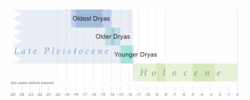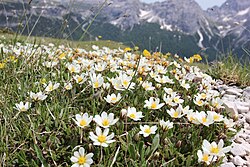Younger Dryas
The Younger Dryas (around 12,900 to 11,700 years ago) was a cold period.[1] It reversed the gradual climatic warming which started around 20,000 years ago.
At this time there was a sharp fall in temperature over most of the Northern Hemisphere. This occurred at the end of the Pleistocene epoch and just before the present, warmer, Holocene epoch.
The last glacial maximum (LGM) was about 27,000 to 24,000 years ago. The Younger Dryas was the most recent and longest of several interruptions to the gradual warming of the Earth's climate. The change was relatively sudden, and it resulted in a decline of temperatures in Greenland by 4 to 10 °C (7.2 to 18 °F)[3] Glaciers and dry conditions spread over much of the temperate Northern Hemisphere. It may have been caused by a large amount of fresh, cold water moving from North America to the Atlantic.[4]
The Younger Dryas was a period of climatic change. The effects were complex and variable. In the Southern Hemisphere and some areas of the Northern Hemisphere, such as southeastern North America, a slight warming occurred.[5]
Younger Dryas Media
Temperature changes, determined as proxy temperatures, taken from the central region of Greenland's ice sheet during the Late Pleistocene and beginning of the Holocene.
Dryas octopetala is the indicator species for the period
References
- ↑ Rasmussen, S.O.; Andersen, K.K.; Svensson, A.M.; Steffensen, J.P.; Vinther, B.M.; Clausen, H.B.; Siggaard-Andersen, M.L.; Johnsen, S.J.; Larsen, L.B.; Dahl-Jensen, D.; Bigler, M. (2006). "A new Greenland ice core chronology for the last glacial termination" (PDF). Journal of Geophysical Research. 111 (D6): D06102. Bibcode:2006JGRD..111.6102R. doi:10.1029/2005JD006079. ISSN 0148-0227.
- ↑ Zalloua, Pierre A.; Matisoo-Smith, Elizabeth (2017). "Mapping Post-Glacial expansions: the peopling of Southwest Asia". Scientific Reports. 7: 40338. Bibcode:2017NatSR...740338P. doi:10.1038/srep40338. ISSN 2045-2322. PMC 5216412. PMID 28059138.
- ↑ Buizert, C.; Gkinis, V.; Severinghaus, J.P.; He, F.; Lecavalier, B.S.; Kindler, P.; Leuenberger, M.; Carlson, A.E.; Vinther, B.; Masson-Delmotte, V.; White, J.W.C. (2014). "Greenland temperature response to climate forcing during the last deglaciation". Science. 345 (6201): 1177–1180. Bibcode:2014Sci...345.1177B. doi:10.1126/science.1254961. ISSN 0036-8075. PMID 25190795. S2CID 206558186.
- ↑ Meissner, K. J. (2007). "Younger Dryas: A data to model comparison to constrain the strength of the overturning circulation". Geophys. Res. Lett. 34 (21): L21705. Bibcode:2007GeoRL..3421705M. doi:10.1029/2007GL031304. S2CID 36884445.
- ↑ Carlson, A.E. (2013). "The Younger Dryas Climate Event" (PDF). Encyclopedia of Quaternary Science. Vol. 3. Elsevier. pp. 126–34. Archived from the original (PDF) on 11 March 2020.
![Temperatures in the postglacial period, after the Last Glacial Maximum (LGM). There were very low temperatures for the most part of the Younger Dryas, rapidly rising afterwards to reach the level of the warm Holocene. This is based on Greenland ice cores.[2]](https://upload.wikimedia.org/wikipedia/commons/thumb/6/63/Evolution_of_temperature_in_the_Post-Glacial_period_according_to_Greenland_ice_cores_%28Younger_Dryas%29.jpg/500px-Evolution_of_temperature_in_the_Post-Glacial_period_according_to_Greenland_ice_cores_%28Younger_Dryas%29.jpg)





